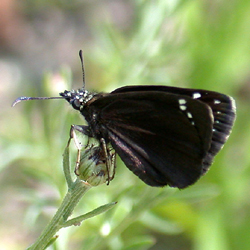Butterfly Atlas
Find a Butterfly
Common Sootywing
Pholisora catullus
Named
Fabricius, 1793

Identification
Wingspan: 7/8 to 1 and 1/4". In his Butterflies of New England (1886), Maynard refers to this butterfly as the "white dotted black skipper." This common name describes the present species well, and although it is superficially similar to several other dark skippers, its small size, glossy black (at times dark brown) coloration, and double row of minute white dots on the tips and outer margins of the upper forewings readily distinguish this butterfly. Corresponding rows of dots are sometimes apparent on the upper surface of the hindwings. The number and clarity of these dots is variable.
Distribution
Southern British Columbia east along the Canadian-United States border to southern Quebec and south through most of the United States and into central Mexico; absent from much of peninsular Florida. In New England from southern Vermont and New Hampshire south; several disjunct colonies in southern Maine (Opler, 1992).
Status in Massachusetts
In general this species is common across much of the state. Large gaps in the record, however, indicate that this is an uncommon or rare species on Cape Ann, in northern Worcester County as well as western and southeastern Massachusetts including the Cape and islands. Scudder‘s (1889) characterization of the Common Sooty Wing states "In New England it is not an uncommon insect in some southern localities, notably along the Connecticut River . . ." Maximum: 15 on 28 July 1982, Millis (Norfolk Co.).

Flight Period in Massachusetts
Two distinct flights: mid-May to mid-June and from the third week in July through August. Extreme dates: 10 May 1987, Braintree (Norfolk Co.), R. Abrams and 3 September 1994, Worcester BMBS (Worcester Co.), T. Dodd.
Larval Food Plants
Typical hostplants are members of the goosefoot family including Lamb‘s Quarters (
Adult Food sources
Found nectaring on 8 species of flowering plants by atlas workers including Dogbane, Common Milkweed, Wild Indigo, and Purple Loosestrife.

Habitat
Consistent with the haunts of its hostplants, the Common Sooty Wing is a species of agricultural areas and wasteplaces. Typical localities include farm fields and gardens as well as dumps and abandoned lots.
Life Cycle
EGG: White to reddish-tan; dome-shaped and squat with vertical ribs and swollen areas at the top. OVIPOSITION: Eggs laid singly on upper surface of host plant leaf. LARVA: Pale green with light flecks; the head is black. PUPATION: Unrecorded? CHRYSALIS: Light brown with a grayish bloom. OVERWINTERING STAGE: Mature larvae of the second generation overwinter in a leafy case that is normally lined with silk.
In Massachusetts, the season‘s first flight of Common Sooty Wings peaks in early June. A walk along the edge of a newly planted field may flush one of the adults where its quick and erratic flight, close to the ground, may leave the casual observer puzzled as to its ultimate whereabouts.
Account Author
Richard K. Walton



